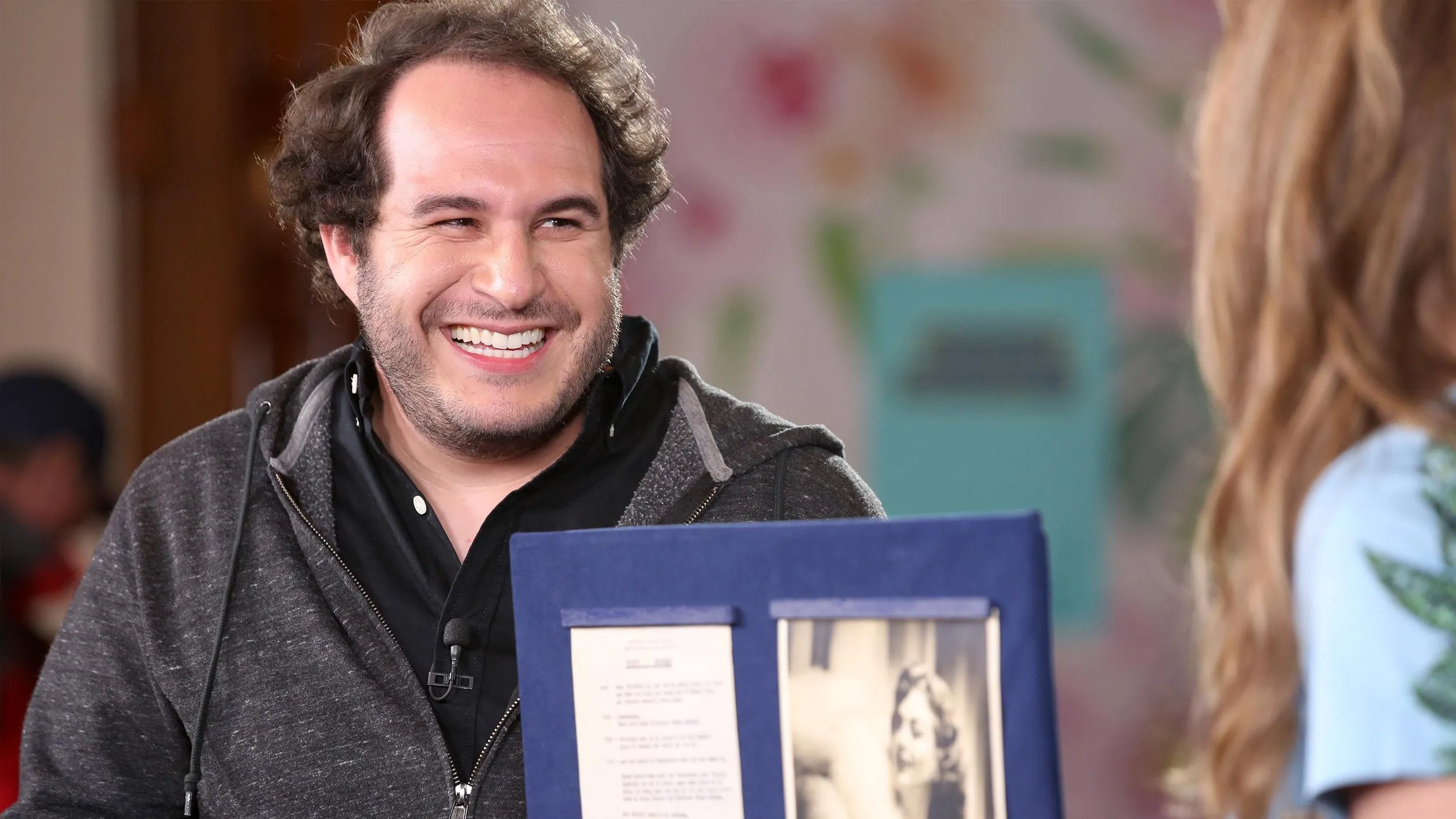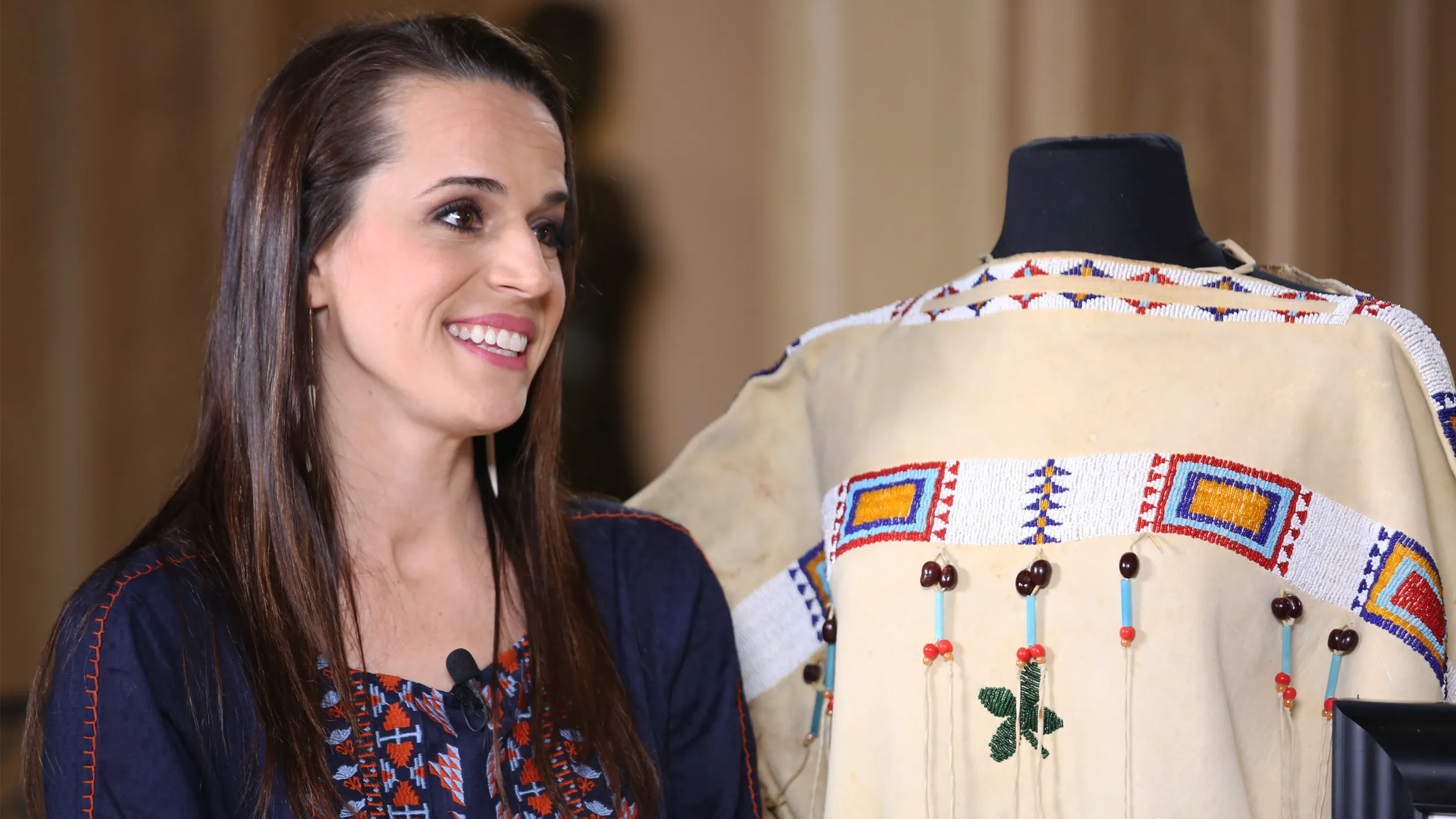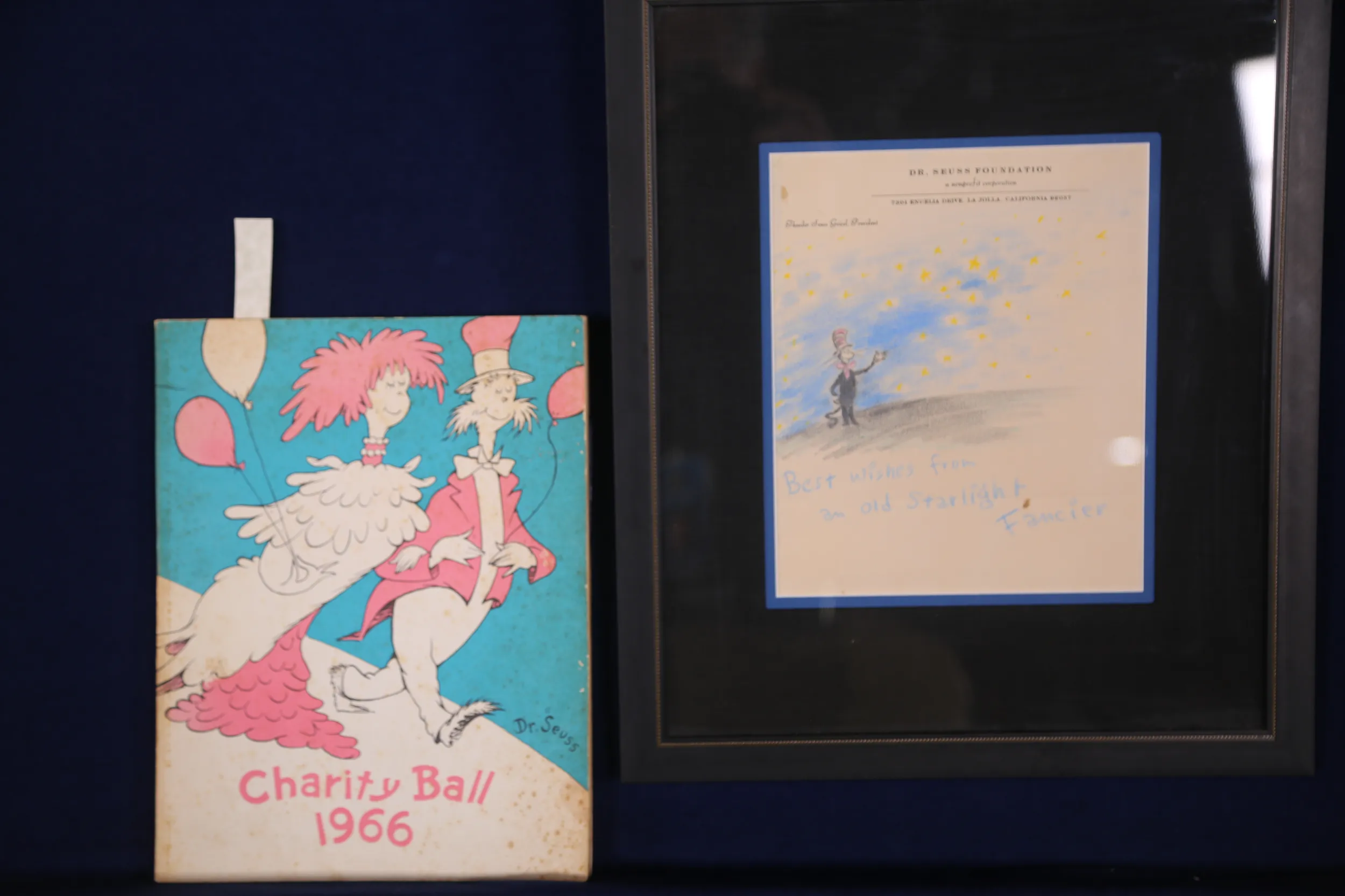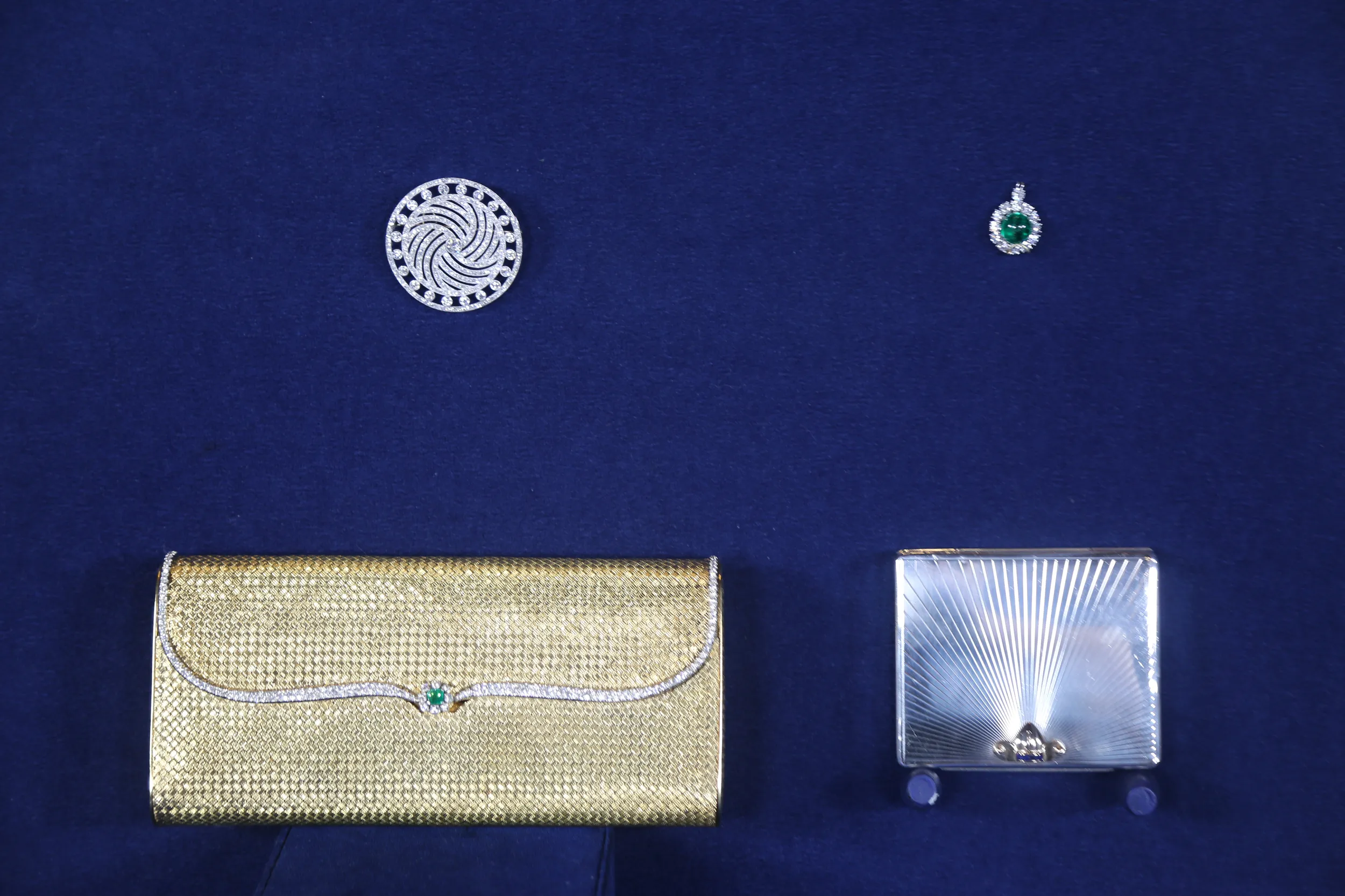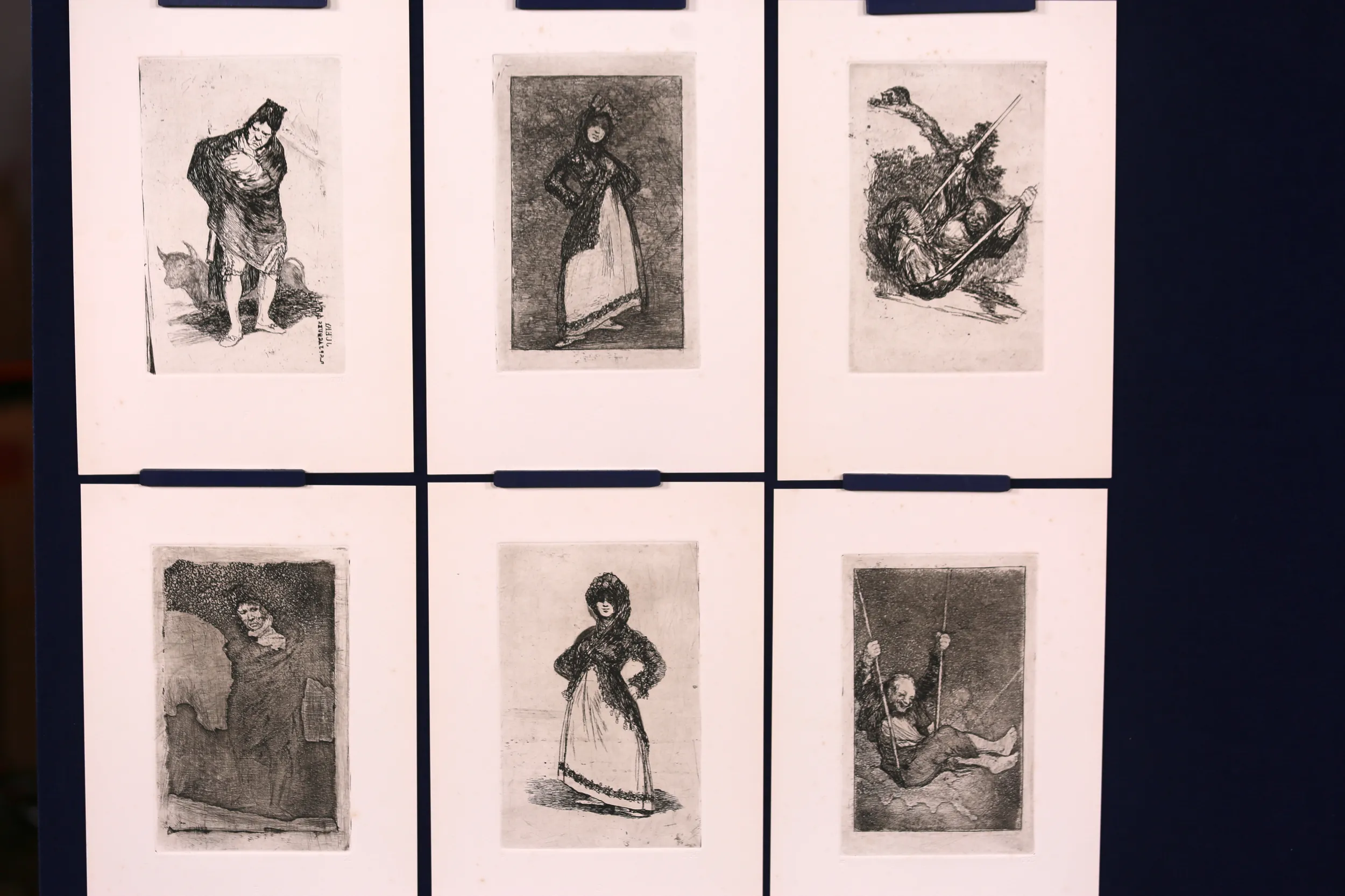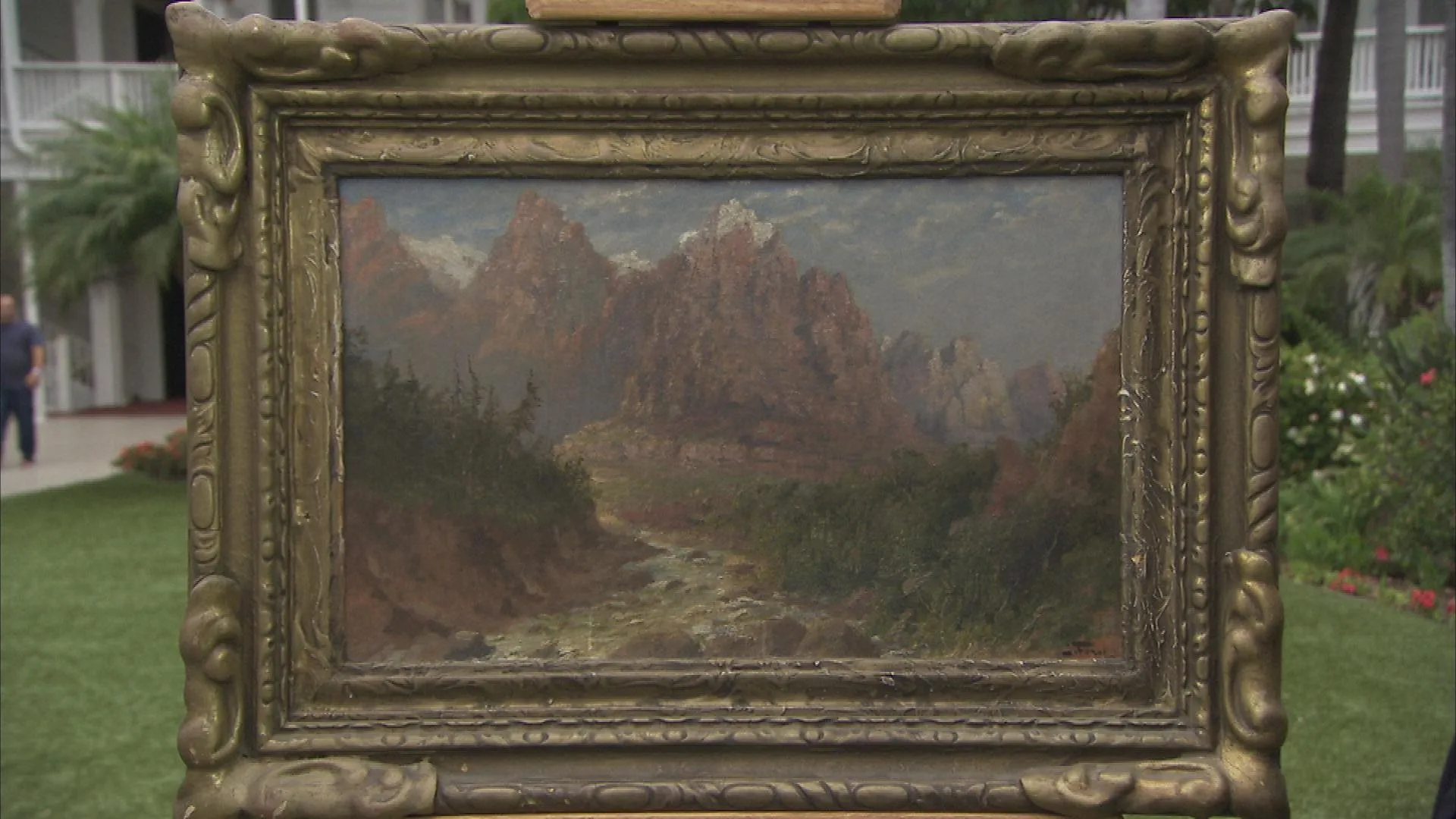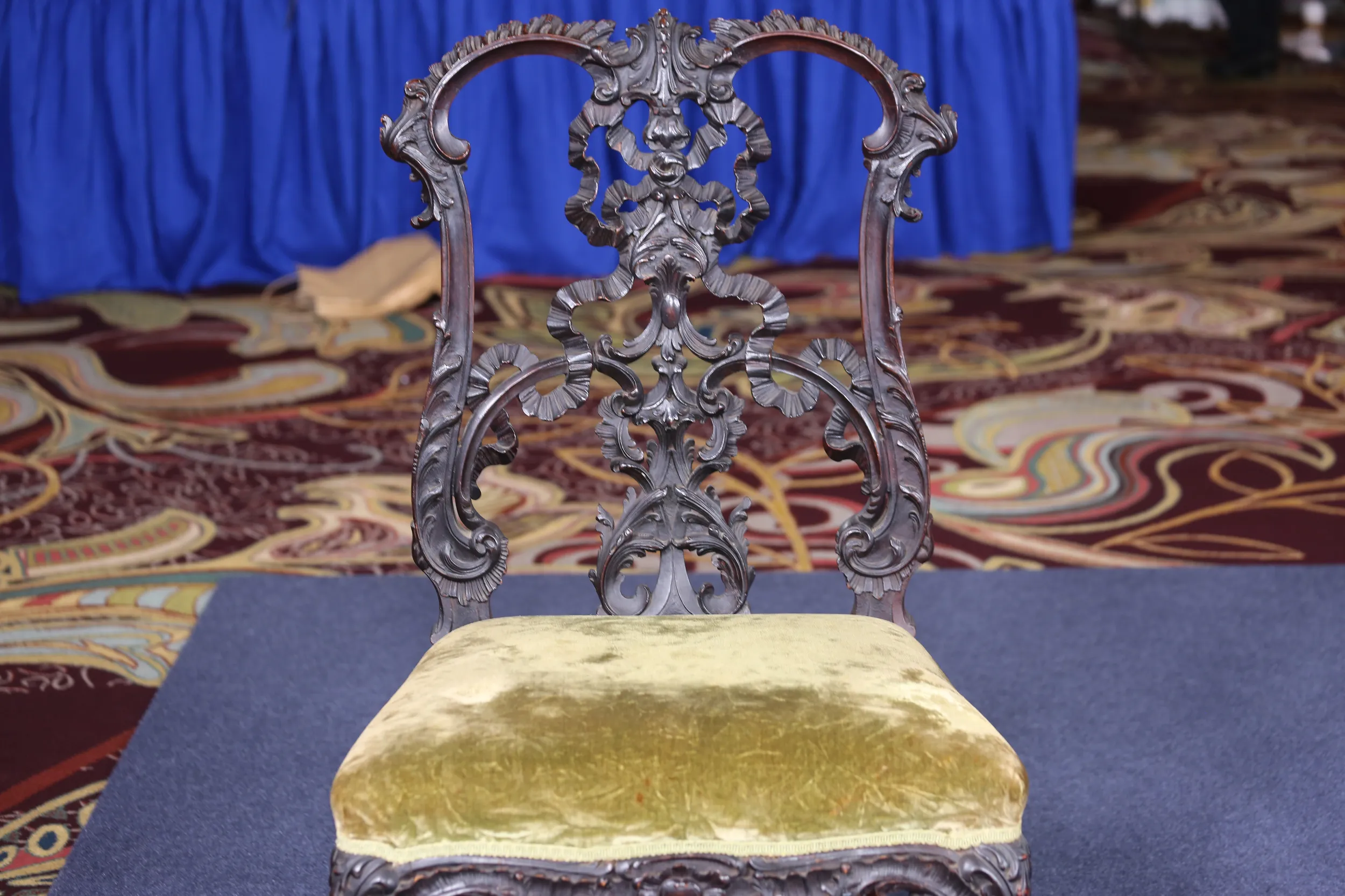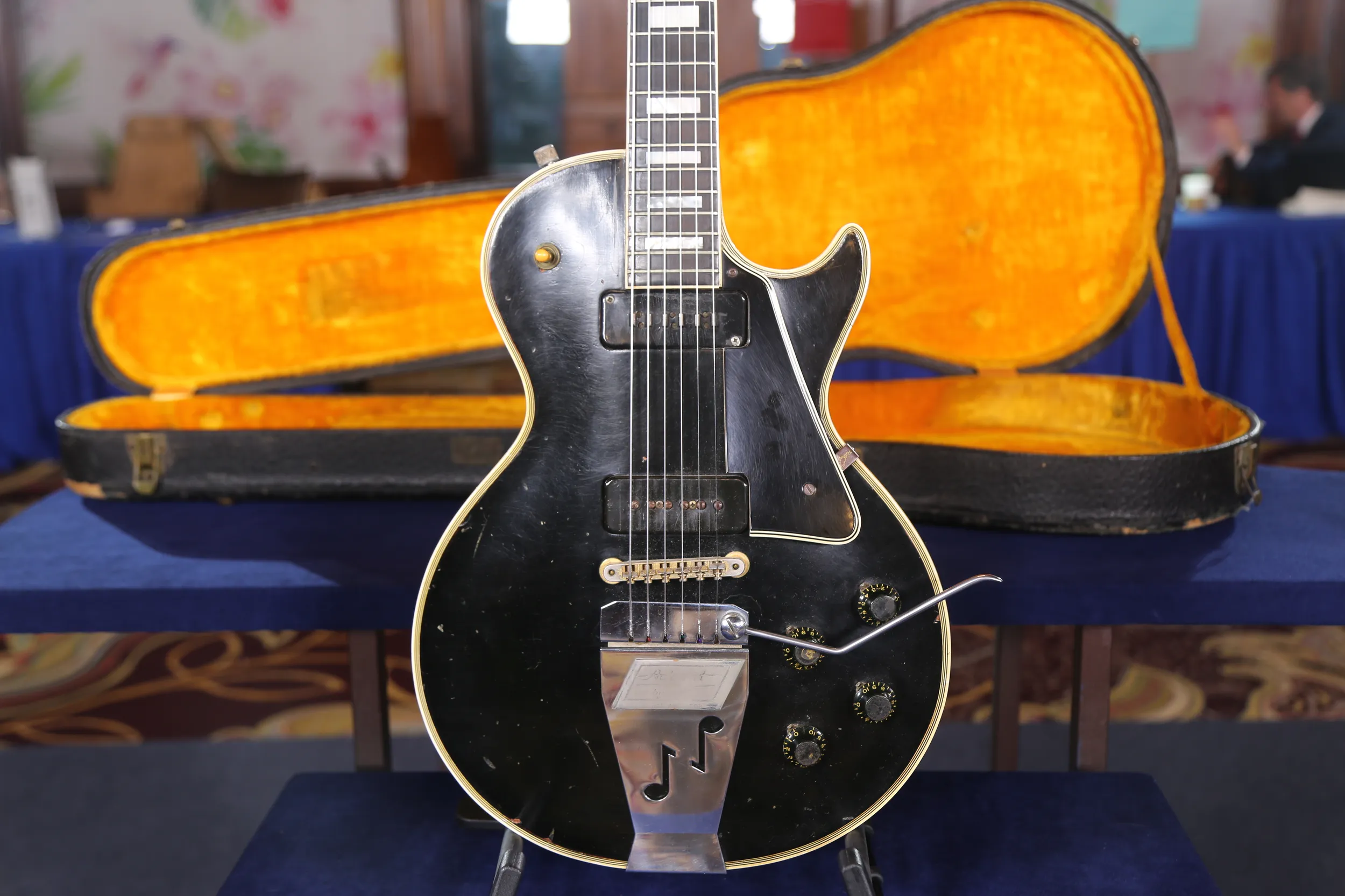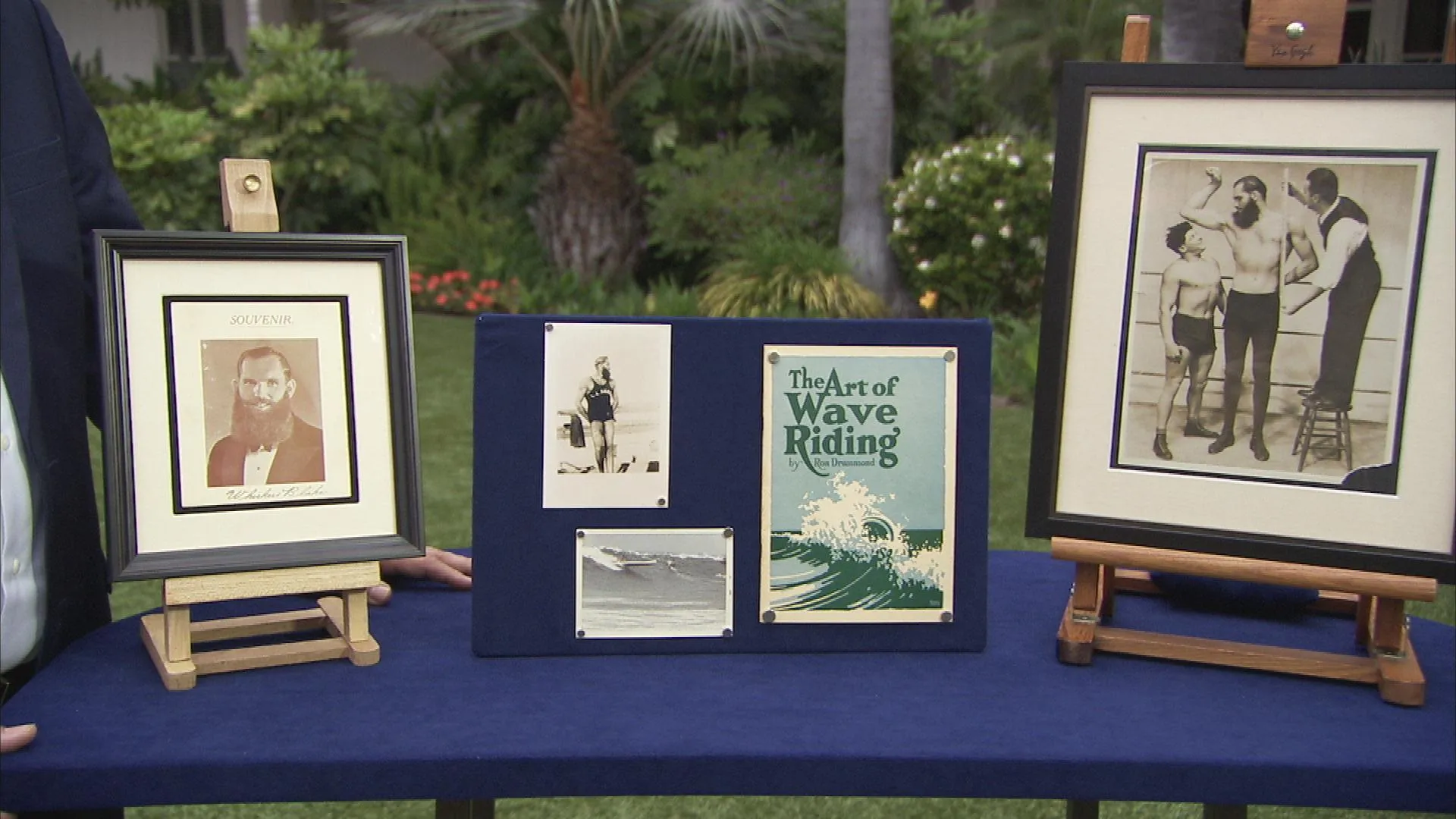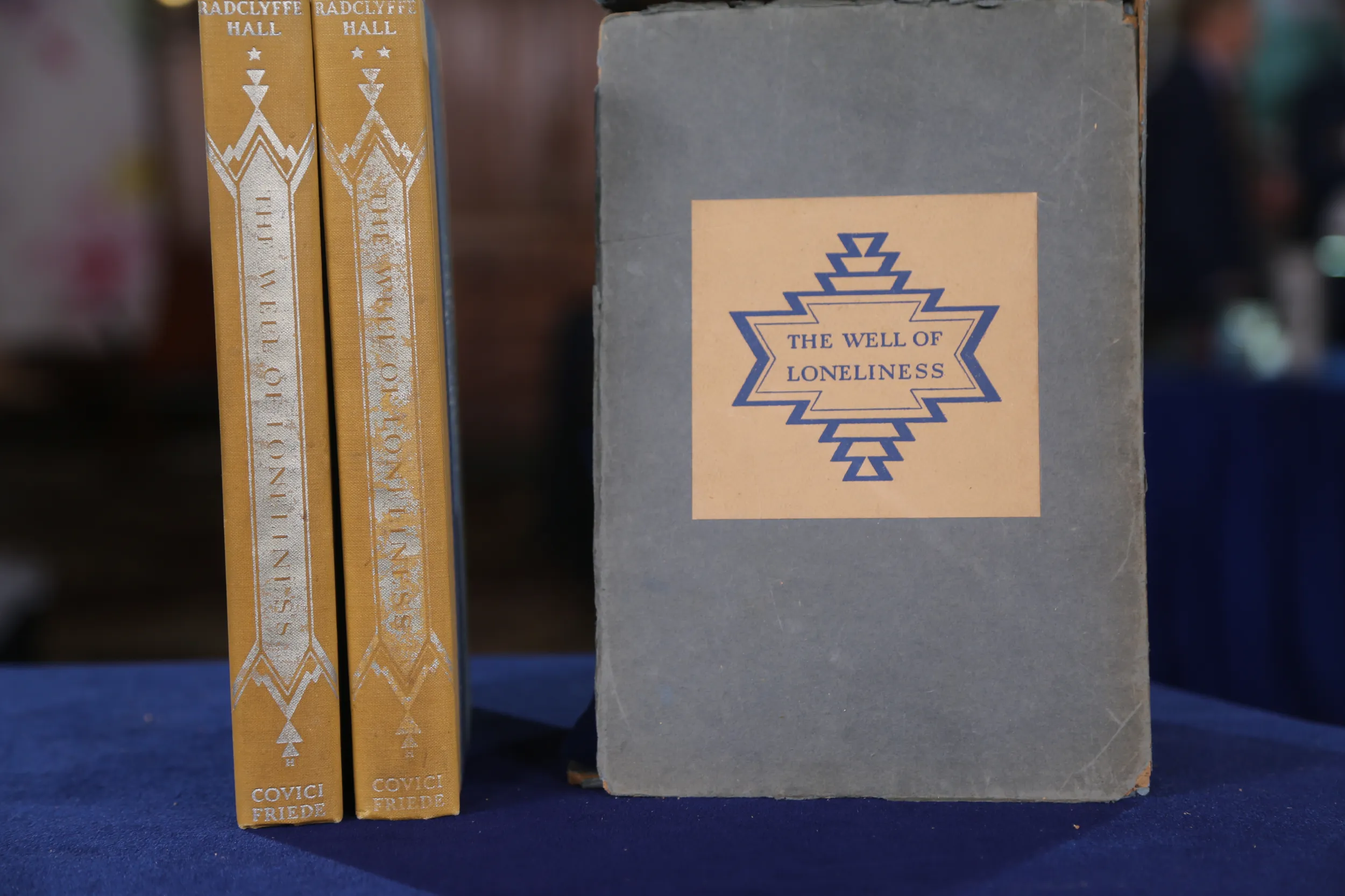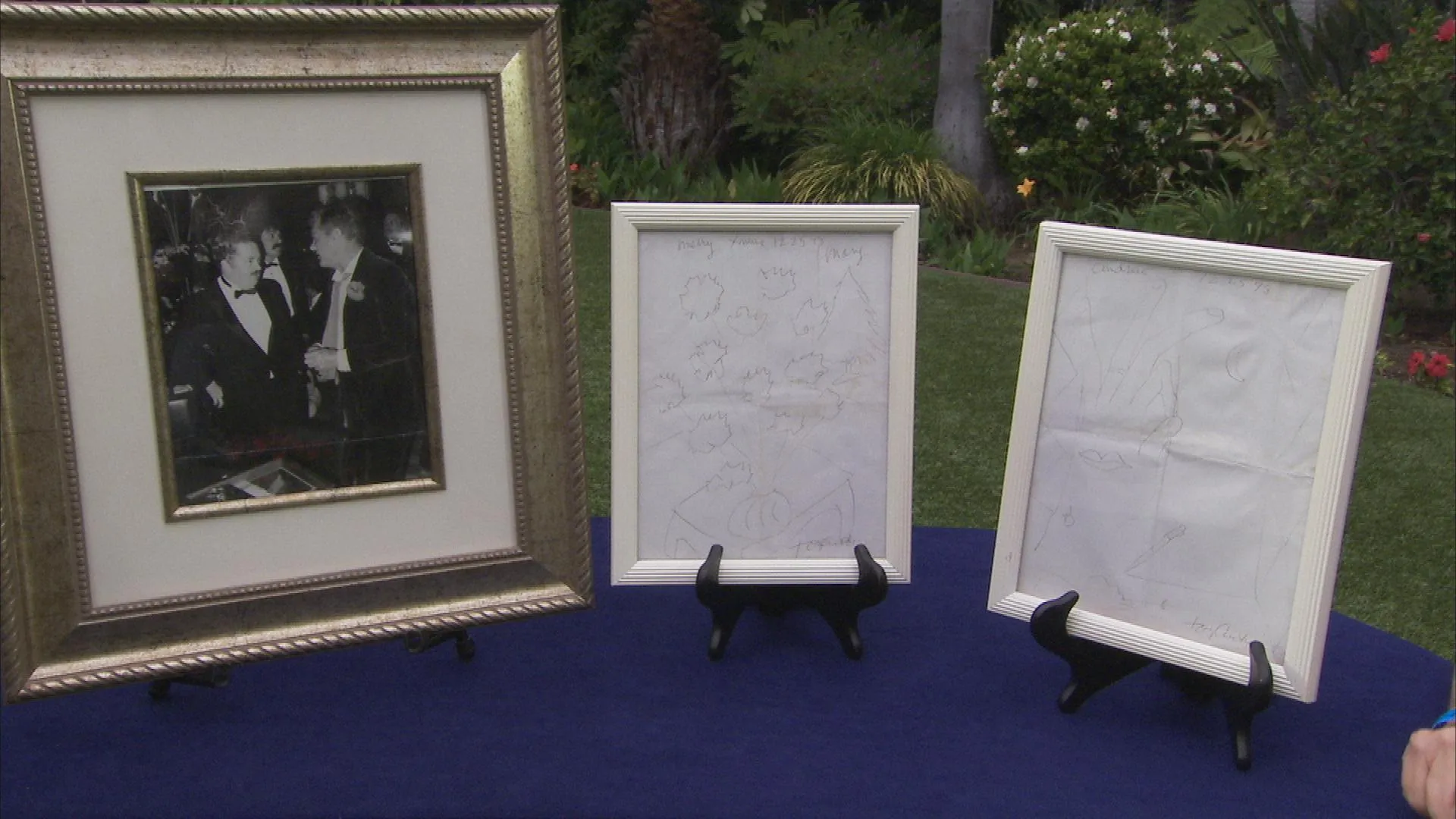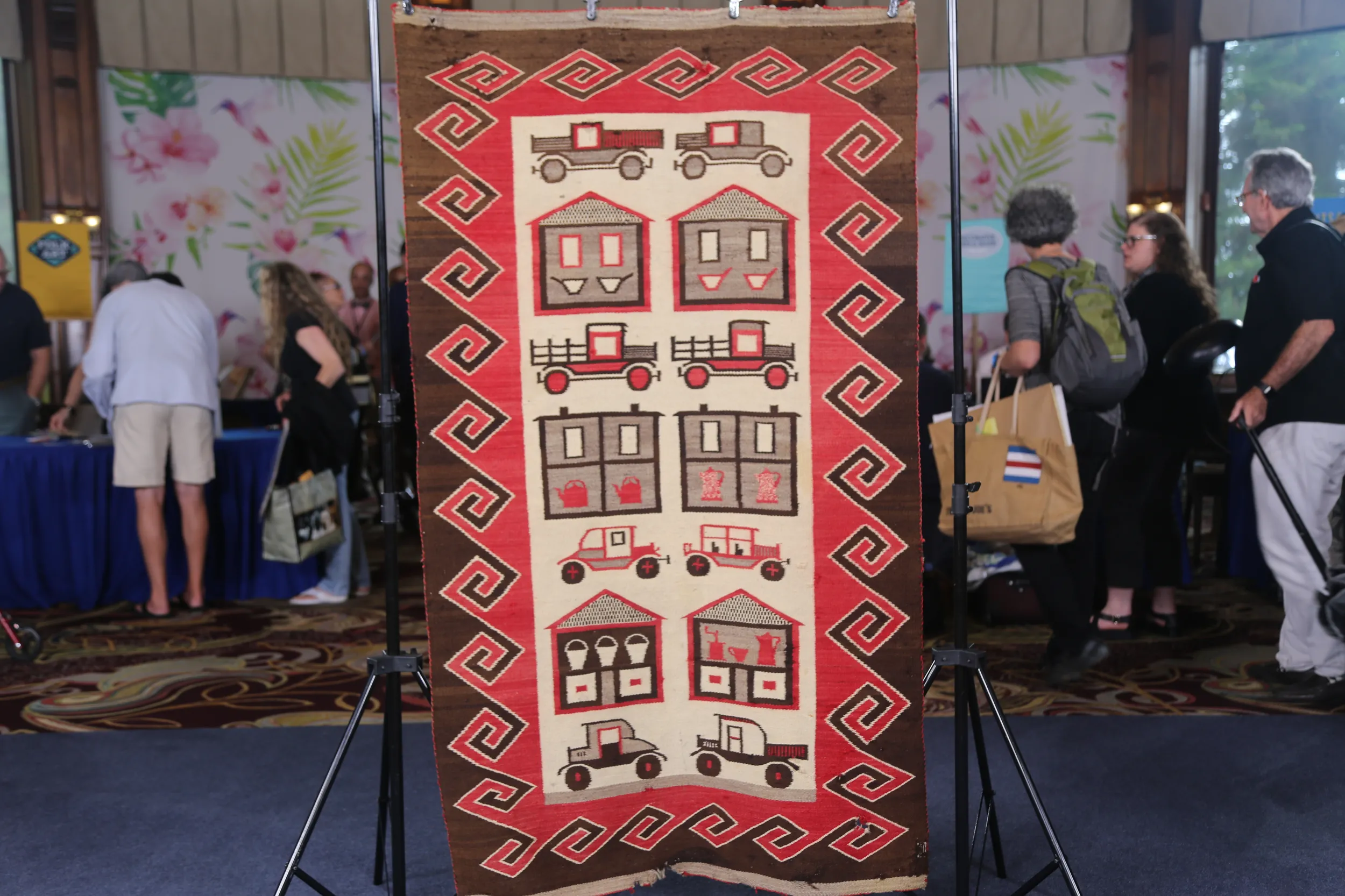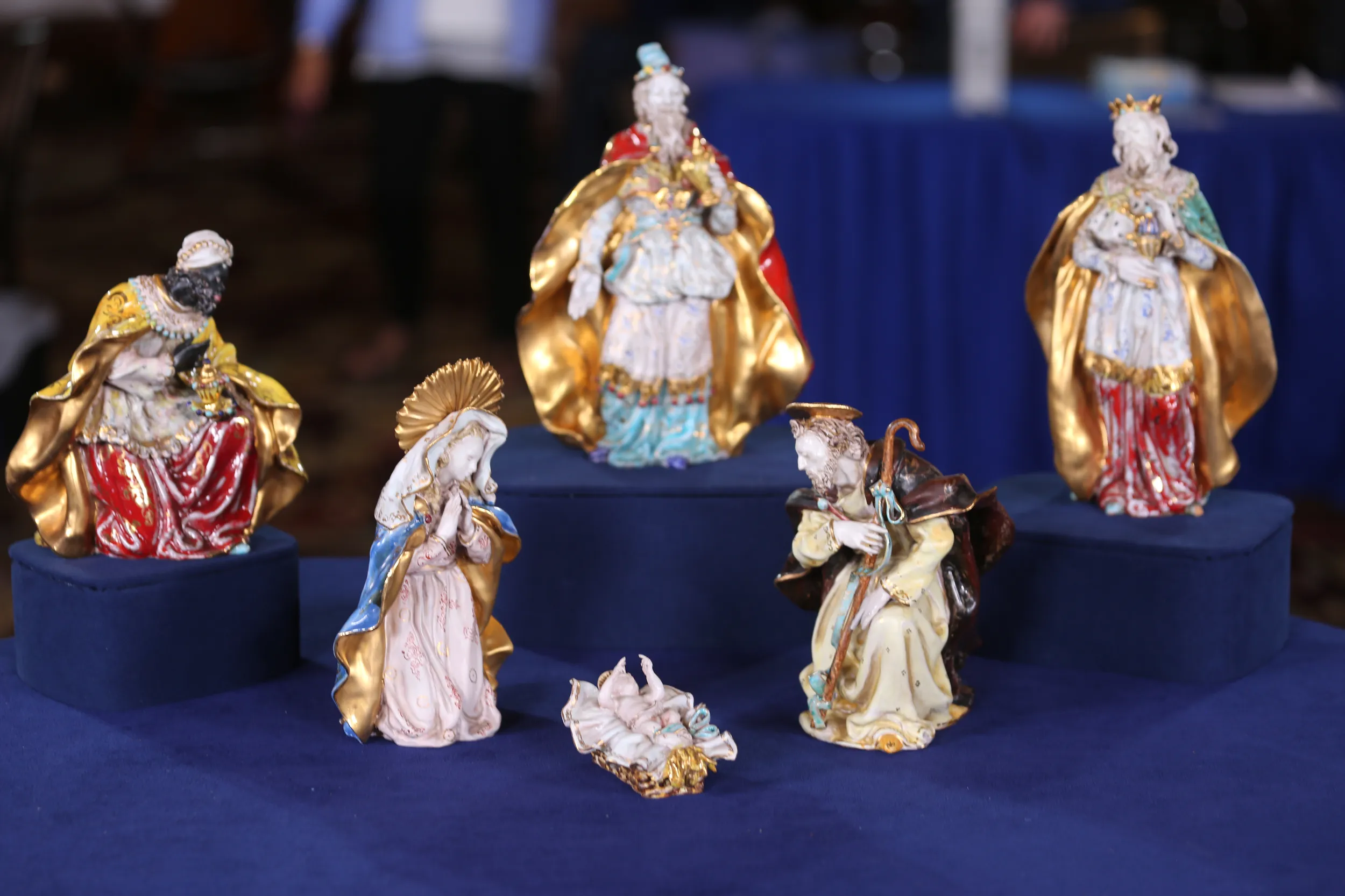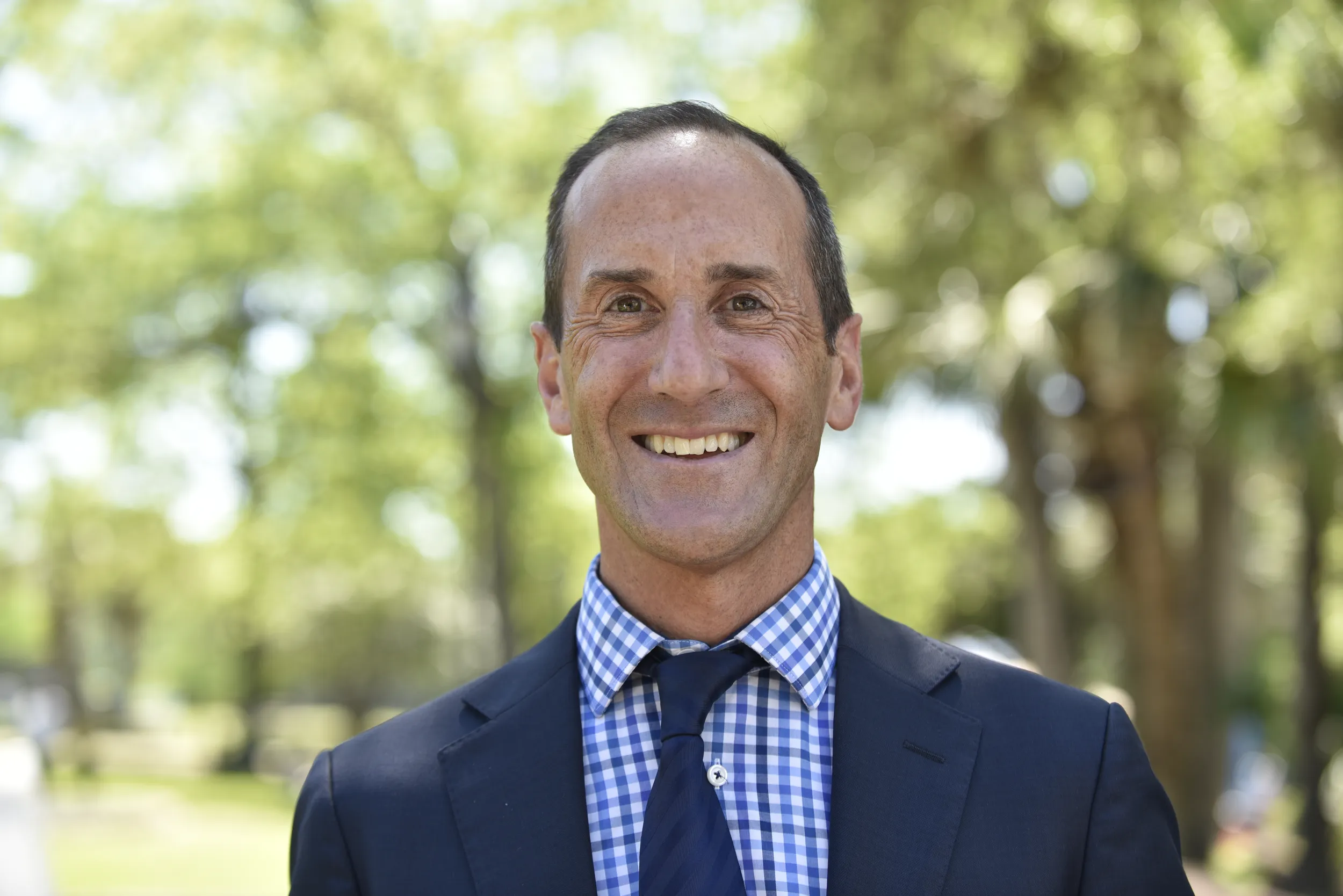HOST: ANTIQUES ROADSHOW is mining the Treasures of the Golden State.
APPRAISER: Where are we today?
GUEST: We're right at the Hotel del Coronado, in the large ballroom.
APPRAISER: Wow, so you've run the elevator here at the Hotel del Coronado for 38 years.
GUEST: Yeah.
HOST: Over the decades, the iconic Hotel del Coronado has accommodated hundreds of thousands of guests, including presidents and Hollywood royalty.
One of the most notable examples of the Del's star quality was its appearance
in Billy Wilder's classic comedy "Some Like It Hot" with Marilyn Monroe, Tony Curtis, and Jack Lemmon. The movie was filmed in spaces outside the hotel in September of 1958. ROADSHOW has set up our cameras all over the Del today,
and there are some amazing treasures in the spotlight.
APPRAISER: A lot of people think that the jewels are actually what makes them expensive. The jewels are actually really on pivot points. It's better to have that rubbing against each other than metal on metal.
GUEST: Look at how good shape this thing is still in.
APPRAISER: Yeah, totally could use that.
GUEST: Yeah!
APPRAISER: I mean, clean it out.
GUEST: Yeah.
APPRAISER: But it only makes, like, enough for just one person.
GUEST: I know.
APPRAISER: So, this was made around 1915, because it has an "M" letter after the number.
GUEST: My husband and I were known for theater in San Diego. We were a dance team, a director, and choreographers. And we did the charity ball right at the Hotel del Coronado, and the large ballroom is where we did that ball. My husband and I did the entertainment portion,
APPRAISER: Mm-hmm.
GUEST: so we got members of the committee, who are all benefactors for this city,
APPRAISER: Right.
GUEST: and we had them do a dance. And then we had regular entertainment,
where my husband and I performed, and others too.
APPRAISER: So how does it feel to be right back in the action, where you were in 1966?
GUEST: I love the Hotel Del, it has been-- and my husband and I came and stayed here every year.
APPRAISER: When we open the program, we see your name right here, Bonnie.
GUEST: Yes.
APPRAISER: Bonnie Ward, assistant choreographer, and Don was your husband?
GUEST: Husband.
APPRAISER: Very cool. This whole thing has been Seuss-ified. You have Sneetches, you have from "Horton Hears a Who," you have "Cat in the Hat." But while the illustrations in the book are very interesting, this is what we're here to talk about today.
GUEST: Oh, okay.
APPRAISER: So how... tell me how you got the drawing.
GUEST: This is several years thereafter.
APPRAISER: Okay.
GUEST: My husband and I became artistic directors of Starlight Opera. And during that time, Ted Geisel came into our office, and would talk to the people, and he was a benefactor of Starlight as well. We said, "Would you like to make us a little thing?" And he was always drawing on things-- napkins and things at lunches-- and our staff adored him. And when Starlight closed down, my husband and I said, "Well, we're going to take that home," because it's so adorable.
APPRAISER: I love how you refer to him as Ted because, I mean, growing up, he's the Doctor. Dr. Seuss.
GUEST: Yes, Dr. Seuss.
APPRAISER: He was born in Springfield, Massachusetts.
GUEST: Really?
APPRAISER: And then he hopped...
GUEST: yeah,
APPRAISER: and then he moved and became a West Coast guy. He began his illustration career right around 1930, going into the '40s.
GUEST: Yes.
APPRAISER: But once World War II hit, he took a break from child's illustration, and he did a lot of work for the military. But once you get out of World War II is where all the fun happens. You have "Cat in the Hat," "Horton Hears a Who," "Green Eggs and Ham." I mean, "Sam I am, green eggs and ham," that was my bread and butter growing up. That was my favorite Dr. Seuss book.
GUEST: Right. Right.
APPRAISER: And when it comes to an illustration by him, when it comes to determining a value, there are a lot of different factors that you have going on here.
GUEST: Uh-huh.
APPRAISER: So, it's not signed by him, but what's really interesting is the annotation here: "Best wishes from an old Starlight fancier." So he was a contributor to the Starlight.
GUEST: And an audience member, always.
APPRAISER: Talk about a nice homage to the Starlight, because you have Cat in the Hat waving to a sky full of stars.
GUEST: Isn't it lovely? Our theater's an outdoor theater.
APPRAISER: Oh, that's perfect! So, why not, under the night sky, right?
GUEST: He didn't miss a trick. And he did all of the illustrations in here for each company.
APPRAISER: I mean, that's what's honestly very impressive. Each ad is Seuss-ified.
GUEST: Seuss-ical.
APPRAISER: That's the word of the day, Seuss-ified.
GUEST: Seuss-ical, yeah.
APPRAISER: You have every page just loaded with great illustrations for every advertisement, which is unbelievable. So, in today's world, as a collectible, the book's worth about $200 to $300 on the market. But the drawing, on the other hand, even though it's not signed, the fact that it's on actual Dr. Seuss Foundation letterhead is huge.
GUEST: Yeah, yeah.
APPRAISER: That is very crucial. That just adds to the whole package of what you have going on here. The subject matter of Cat in the Hat, you can't get any better. It's one of his most iconic characters, that he ever created.
GUEST: Absolutely.
APPRAISER: And even though it's not an illustration, something directly adapted from one of his books, it's still a full figure, it's full color, and it's a great subject matter. In today's world, at auction, a conservative estimate would be $1,000 to $1,500.
GUEST: Wow.
APPRAISER: With the book being 200 to 300 as a total package, I could see it potentially reaching $2,000 at auction. When you brought this to the table, I wanted to take you for a twirl!
APPRAISER: I honestly... and I would love to see you bust a move like it's back in 1966!
GUEST: I would twirl with you!
APPRAISER: You're right, I think this is ebony.
GUEST: Oh, okay.
APPRAISER: And it does have a lot of age. It's a plantation chair, so it's probably from the 19th century.
APPRAISER: Tell me where you bought it.
GUEST: In Holland.
APPRAISER: Yes?
GUEST: The Netherlands.
APPRAISER: It's what we refer to as a French figural clock. With beautiful French movement that requires winding once a week.
APPRAISER: So you brought me in, whose bracelet?
GUEST: My great-aunt's, but it may have been my great-grandmother's.
APPRAISER: And you said something about it being broken.
GUEST: Yes, I was wearing it to a wedding, and it slipped off. And fortunately someone told me, because I hadn't felt it come off at all. And that made me think, oh, maybe I should find out what it's worth before I wear it again, or if I can wear it again.
APPRAISER: Let me tell you, jewelry is one of the great recycles. Jewelry can be repaired, and then worn generations down the road. And I'm not saying everything can be fixed, but this is fixable. It's what we call in the business "tired."
GUEST: Uh-huh, yeah.
APPRAISER: It's got some issues. But where it's broken here is really not that big a deal. I can see it's been repaired in a few places before.
GUEST: Oh, okay.
APPRAISER: But it's really in pretty good shape. So, it's... you notice it's a little heavy. So it's constructed of platinum.
GUEST: Oh, okay.
APPRAISER: And then you have single-cut and rose-cut diamonds mixed. And then the sapphires, we call them calibrated sapphires, because they're cut to exacting specifications. In a lot of these old bracelets from the 1920s and '30s, you'll find synthetic sapphires.
GUEST: Okay. So these are synthetic?
APPRAISER: No, these are real.
GUEST: Oh, okay! (laughing)
APPRAISER: So that's great.
GUEST: Uh-huh.
APPRAISER: So, look, if you were going to sell this to somebody, and you said, "Gee, I'm never going to wear it again," there's maybe $1,000 to $1,500 here.
GUEST: Okay.
APPRAISER: But the fact of the matter is, you take this in and a good jeweler sits down and fixes it. The cost of repairing this is probably around somewhere between $500 and $700, to do it right.
GUEST: Oh, okay, yeah.
APPRAISER: And then all of a sudden, you're going to have a bracelet that's going to be, at auction, $3,000 to $4,000.
GUEST: Oh, okay. I can still wear it at that price, too, then. I don't have to worry about losing it. (laughing)
HOST: "Some Like It Hot" had big-name actors, but this photogenic dragon tree became a star in a scene where wealthy suitor Osgood Fielding III, played by Joe E. Brown, courts Daphne, played by Jack Lemmon. Almost as old as the Del itself, the dragon tree is native to the Canary Islands.
GUEST: This belonged to my mother and she passed away-- it was two years in April-- and she was originally from Pittsburgh, Pennsylvania, and she was quite a social, beautiful woman who was very interested in fashion and entertaining. I would imagine a lot of these were gifts. My mom was married twice, she was a beautiful woman, and she was a collector.
APPRAISER: So I was drawn to this collection today because it's a wonderful snapshot of four of the major jewelry periods or movements. So we have here, beginning with this beautiful brooch, from the Art Deco period. The Art Deco period spanned from 1920 to 1930, and it was a period of extreme opulence and extravagance in our country. So women wore brooches during the day, they wore them at night, and they wore them to complement their very simple, flapper dresses from that time. It's comprised of platinum and diamonds. The center diamond weighs about a half a carat, and it's framed by additional old European-cut diamonds and single-cut diamonds. I calculated that the total carat weight for the whole brooch is about six carats worth of diamonds. I wish I could tell you exactly who it was made by. There are no marks on the back. My guess is that it was made in America in New York City somewhere between 1925 and 1930. At auction today, just for that brooch, I would say it's worth about $7,000.
GUEST: Great.
APPRAISER: After we have this wonderful example of 1920s, we come here to this compact. It is from the Retro period. The Retro period dated from about 1935 to 1950. So we have here an example of a silver and gold compact with sapphire set clasps. When I was looking at this compact, I noticed that it is signed by Tiffany and Company, and this is a beautiful example from the time. This is a larger compact, it probably would have been used for cigarettes as a cigarette case rather than to powder your nose. And at auction today, I would expect the cigarette case to bring about $1,000. Following the Retro jewelry period we come to the 1950s. This was a period of extreme economic growth and success, so we have very heavy 18 karat gold woven body of the purse with a very beautifully decorated diamond and emerald clasp. The handbag is Italian. I don't know who made it or who retailed it. It was probably retailed in our country, most likely retailed in New York City. Just the gold alone weighs 300 pennyweights, which today is worth $14,000. When I take the rest into account, including the design, the craftsmanship, and the
materials used, I would say at auction that evening bag is worth about $20,000.
APPRAISER: And, finally, we have this beautiful pendant that is made by Van Cleef & Arpels. And we see that here with a signature on the back, it says, "VCA, New York," with a serial number. This emerald and diamond pendant would have been mounted by Van Cleef in the 1960s. The emerald, based on the color and the quality and the inclusions, to me, appears to be a Colombian emerald. I calculated that the total carat weight of this emerald is about five-and-a-half carats, it's framed by about two-and-a-half carats worth of diamonds. It's a very beautiful piece, and at auction today, I'd say it's worth about $10,000. I would expect the entire collection to bring about $38,000.
GUEST: Oh, thank you, Lucy. (voice breaking) She'd be so pleased. She would. Thank you.
APPRAISER: It's not dots, dot matrix are very easy to tell. But if you look at them through a magnification, you see like a cellular pattern. It's big, it's attractive, so it
does have some value, but its value is decorative.
APPRAISER: But most of these portrait plaques came out of Germany, or Austria, or France. You don't see it coming out of China. And it's obviously they were catering to a Western market.
GUEST: I bought this at an open-air flea market about ten years ago.
APPRAISER: Uh-huh, you paid roughly...?
GUEST: It was a couple hundred.
APPRAISER: Couple hundred dollars? What attracted you to it?
GUEST: Well, it's odd, I've never seen another one. I know carriage clock. But I didn't know what this was, so I still don't know.
APPRAISER: Right, right.
GUEST: (chuckles)
APPRAISER: This was actually a thermostat during a time in which you had to go downstairs and manually stoke your furnace
GUEST: Yes.
APPRAISER: or manually adjust your furnace if you wanted a variation in temperature.
GUEST: I see.
APPRAISER: This would do that for you.
GUEST: Ah.
APPRAISER: And this was probably around 1912 or 1915 or so.
GUEST: Really? Ah, that's so cool!
APPRAISER: So it's one of the first automated thermostat.
GUEST: Automated thermostat.
APPRAISER: And of course it's mechanical.
GUEST: Yes, yes.
APPRAISER: Yeah.
GUEST: Wow, okay.
APPRAISER: Think of how far we've come.
GUEST: That's come a long way, huh?
APPRAISER: Yeah, now we can set it for a week and we never have to worry about it.
GUEST: Right, right.
APPRAISER: So this was made by the Minneapolis Movement Company in Minneapolis, Minnesota, and a very unusual model.
GUEST: Thanks.
APPRAISER: The carriage clock alone on this is probably worth $200, $250.
GUEST: Nice.
APPRAISER: Quite easily, I'd say as a setup, or a collector's item, it has to be worth somewhere closer to $350.
GUEST: Nice, very good, thank you!
APPRAISER: Appreciate you bringing it in.
GUEST: Thank you very much, yeah.
APPRAISER: What's the temperature?
GUEST: It feels like about 63 and mild. (laughing)
GUEST: I like to go to estate sales. I'm sure I picked this up at an estate sale,
but I don't remember how long ago it was. And I just like to look at nice things, and quality things that most of which I can't afford. And I saw this, and I opened it up, and read the card on the inside, and it said that it was museum quality set, and I thought, "Oh, okay, I'm buying this." (chuckles)
APPRAISER: Do you recall how much you paid for them?
GUEST: It was less than $20 because I don't spend that much. I really didn't know that much about them, and as I started doing research, it said that the whole set should be kept together. And that these were made from the original plates, Goya plates.
APPRAISER: Yeah.
GUEST: And I thought, "Oh, that's pretty nice."
APPRAISER: You have six etchings here by the Spanish master Francisco José de Goya. He was working in the late 1700s into the early 1800s. And he produced this magnificent series of etchings around 1799 called “The Caprichos.”
GUEST: Ah, okay.
APPRAISER: All of which were about this size. And a lot of them condemned what was happening in Spain at the time with the monarchy, and with the disparity in wealth with some aristocrats and a lot of the poor. And Goya parodied this in “The Caprichos” and he only put out a handful of sets. And then fast forward about two decades later in the 1820s, he had moved into self-exile
GUEST: Uh-huh.
APPRAISER: from Madrid to Bordeaux in the south of France,
GUEST: Uh-huh.
APPRAISER: basically to stay out of trouble. This was at the end of his career.
GUEST: Mm-hmm.
APPRAISER: And it's at this time that he produced these images. And they're called "The Late Caprichos of Goya" because they kind of match the size of “The Caprichos” that were made in 1799, his first printed images. But he made these in Bordeaux, and he actually made them on only three plates.
GUEST: Oh.
APPRAISER: So each plate had one of these images on both sides.
GUEST: Uh-huh.
APPRAISER: And he only printed a handful of them in his lifetime, only several lifetime proofs are known of these. After he died, the plates went to his son, his only surviving heir,
GUEST: Uh-huh.
APPRAISER: and in the mid-1850s they went to an English ambassador to France, who brought them back to London. And they found their way onto the London art market, where in the 1930s they were purchased by a Boston philanthropist book collector whose name was Philip Hofer.
GUEST: Okay.
APPRAISER: Who donated his collection to Harvard Library. And when he donated them, he had this set printed and published in 1971. So he had them printed by a New York printer whose name was Emiliano Sorini, and you can see Sorini's stamp
down here, that "E.S."
GUEST: Oh, okay.
APPRAISER: It's a blind stamp.
GUEST: Right.
APPRAISER: and you can see Philip Hofer's initials on the right of each.
GUEST: Right.
APPRAISER: So Hofer had these printed in a set of 150, and this is number 96, so there's only 150 of these known, and they were made for friends of the Library and other institutions. Within the edition of 150, there were 25 deluxe editions. You don't have one of those,
GUEST: Okay.
APPRAISER: but the 25 deluxe editions actually had two sets of the six etchings printed.
GUEST: Oh, okay.
APPRAISER: Any idea what they're worth?
GUEST: No. I tried to look it up online and I saw a wide range.
APPRAISER: Yeah.
GUEST: I saw some of the individual prints, but I was hard-pressed to find a collection.
APPRAISER: Yeah.
GUEST: I did see one and it was $1,000 to $3,000 is kind of the range that I saw, so I have no idea, yeah.
APPRAISER: Yeah.
GUEST: Now even though they're printed much later, posthumously, very few prints were made of these in the 1800s.
GUEST: Uh-huh.
APPRAISER: this is the only way you see them.
GUEST: Oh, really? Okay.
APPRAISER: And, at auction, I would expect the set, in the condition that you have them, which is very good, to bring between $5,000 and $8,000.
GUEST: Oh, my gosh. (laughing) You're kidding.
APPRAISER: No. It's a wonderful group you have by one of the, you know, the most famous Spanish artists of the late 1700s, early 1800s.
GUEST: Wow.
APPRAISER: Late 1920s, early 1930s. Done in platinum-topped gold. Diamonds and aquamarine. And in all these cases, the aquamarines would have been from Brazil.
These, on the other hand, are done in the 1950s.
GUEST: Still from Brazil?
APPRAISER: Still from Brazil.
APPRAISER: So today you've brought us a really interesting painting by John Fery. How did you acquire it?
GUEST: This painting was my great-grandfather's, Charles Rendell Mabey, and he was the governor of Utah.
APPRAISER: Oh, wow.
GUEST: So he acquired this when he was in his term as governor.
APPRAISER: The artist John Fery was born of Hungarian parents in Austria and started his early life there studying in Vienna and Munich. And he comes to the United States in 1883. He is best known for painting views of the west. He absolutely embraced the whole landscape, and so he would go to Yellowstone, and Glacier National Park, and, ultimately, Utah. He was also known for being the artist for the Great Northern Railway. And he painted hundreds of paintings for them and they were used as advertisement to get people to ride the rails to go west and to visit the West. Now this painting has an inscription on the back that dates it July 1920. So he would still have been living in Utah at that time. And it also has the title, it's called, "Three Patriarchs, Zion Canyon, Utah." And the three patriarchs are the three cliffs that you see there. Have you ever had the painting valued?
GUEST: I have not. Nor has anyone in my family, to my knowledge.
APPRAISER: If this were being sold in a gallery, the painting would sell in the range of $25,000.
GUEST: Okay.
APPRAISER: His work is highly coveted and desired. He is best known for his views of Montana, but it really is a very special piece.
GUEST: That's cool. (laughing) Yeah, I'm gonna have to go online and look for some of his other work to see what they look like.
APPRAISER: Yeah.
GUEST: Acquired them from my mother, which came from her mother, and I think they came from my grandfather's great-aunt, Lottie.
APPRAISER: Complicated.
GUEST: Yes. And my mom said, "Don't ever get rid of them." (laughs)
APPRAISER: So, tell me about this chair.
GUEST: Well, this chair has been in our family since the 1920s. It was originally my great-grandparents', and we have always speculated about it, my mom always called it the Chippendale chair. So I think we'd like to know, if possible, how old it is, and whether it is related to Chippen... the famous Thomas Chippendale, as my mom thought it was.
APPRAISER: Okay, so we would look at this chair and the first thing we would call it is Chippendale-style.
GUEST: Okay.
APPRAISER: This chair was actually most likely made in England.
GUEST: Okay.
APPRAISER: And interesting, you say 1920s?
GUEST: Yes.
APPRAISER: It was most likely manufactured somewhere between about 1900 and 1920.
GUEST: Okay.
APPRAISER: But stylistically, it is right out of the design book by Thomas Chippendale.
GUEST: Mmm-hmm.
APPRAISER: So you've got this wonderful carved crest rail, and then moving down this really nicely carved back rest, moving down with these foliate scrolls, and further scrolls. And then after the upholstered seat you've got the wonderful carved seat rail, again with shell carving, and these carved cabriole legs, down to leaf-carved scrolling feet as well.
GUEST: Yes, okay.
APPRAISER: So I'm going to turn this around real quick. And on the back you have this absolutely wonderful custom brace that somebody had made. And you can actually see in a couple of areas where breaks had occurred through here.
GUEST: Mm-hmm, mm-hmm.
APPRAISER: So someone had this custom brace made to support the back rest, which is really--
GUEST: Yeah, we wondered about that.
APPRAISER: Yeah. But then interestingly, one of the ways that when we look at a chair to see how old it is, is we immediately go to this area here.
GUEST: Oh.
APPRAISER: And in the 18th century, this, this would have been three parts. It would have been-- this is called the splat, and then this rail would have been broken up into two parts. You would have had the rail, and then you would have had a thin piece of wood right here called the shoe where the splat would fit in.
GUEST: Mm-hmm.
APPRAISER: So, immediately, when we saw this chair, we all turned it around, we go right to this place, and we know that it is not 18th century, it's later.
GUEST: Okay.
APPRAISER: All signs point to it being early 20th century. I think if I saw this in an antique store today, in this condition, I think a good collector or decorator would love to have it, and I'd expect to see a price between around about $750 and $1,000.
GUEST: Okay.
APPRAISER: All right?
GUEST: Yes, thank you very much.
APPRAISER: Well, thank you for bringing it in today, it's been a joy to look at.
GUEST: Thank you.
HOST: Eleven U.S. presidents are known to have visited the Hotel del Coronado. The first was President Benjamin Harrison, who reportedly took his rail car to Coronado in 1891 and ate breakfast here before continuing on his
cross-country tour.
GUEST: My grandfather gave me this guitar when I was about 12, 12 or 13, 1967 or '68. And it's a 1955.
APPRAISER: It's from late 1955, which is about two years after it was introduced.
GUEST: Mm-hmm.
APPRAISER: And this guitar was $325 in 1955 when it was new.
GUEST: That's a lot of money.
APPRAISER: That was a lot of money in 1955.
GUEST: Yeah.
APPRAISER: It was Gibson's attempt to come up with a fancier, more deluxe Les Paul. So it had a lot of features that the regular Les Paul lacked, including all the extra black and white binding around the edges,
GUEST: Mm-hmm.
APPRAISER: and the pearl inlay on the Fingerboard had better tuners than the regular Les Paul. The split block pearl inlay on the head stock. So it was a serious...
GUEST: Fancy.
APPRAISER: ...serious piece of gear, and a major step up from the regular Les Paul, which had a gold top at this point.
GUEST: Oh.
APPRAISER: So this was quite different, you would have-- if you saw them both in the showroom, there would be this kind of gold, metal flake colored Les Paul, and then this one, which they called "The Black Beauty,"
GUEST: Ah.
APPRAISER: 'cause it was pearl, and white, and black, and very dramatic.
GUEST: Yes.
APPRAISER: So it came in two versions. So one version had a Bigsby tail piece with a vibrato. And the other version had a stoptail piece. This guitar originally had the stoptail piece, but whoever had it wanted to be able to, you know, use a whammy bar
GUEST: Yeah. (laughs)
APPRAISER: and so they filled the holes for the stoptail piece.
GUEST: Ah.
APPRAISER: And bought this after-market tailpiece with the whammy bar on it. That was a major, major change, but it meant that they could get that, you know, kind of tremolo sound. Unfortunately, that didn't do a lot for its value.
GUEST: Lowers the value.
APPRAISER: It's a really nice version, it has, you know, all its original hardware, except for that change, and the original case, and the finish has some wear, but it's all what we would call honest wear.
GUEST: Yeah, it's been played.
APPRAISER: Tell us about what you played on it.
GUEST: I played... "In-A-Gadda-Da-Vida," and "Evil Ways," and all kinds of music like that in an all-girl band in the '70s.
APPRAISER: How many years did that band last?
GUEST: One. (laughing) One and a half, maybe. But we had two or three gigs.
APPRAISER: In its current condition, in a vintage specialty shop, it would probably sell for about $12,000.
GUEST: Awesome.
APPRAISER: But that's about two-thirds of what it would sell for if it hadn't been modified.
GUEST: Oh...
APPRAISER: So a 1955 with its original stoptail piece in the same condition would be closer to $18,000, maybe even $20,000.
GUEST: Yeah. Well, that's okay, it's a family heirloom, and it's going to stay in the family. Get the band back together.
APPRAISER: Lots of times people do that. They'll track down the ol' pals and...
GUEST: Yeah, lots of times they shouldn't.
APPRAISER: It's an oil on canvas. It's not signed on the canvas itself. But that doesn't surprise me if it were used for an illustration. Sometimes these works are used in a magazine.
APPRAISER: These are the vertebra of a shark. And typically these shark vertebra canes are English. And the head here is a piece of pressed horn.
GUEST: Horn?
APPRAISER: Horn, like a... cow horn. It's probably from around the turn of the century, 1900, 1910.
GUEST: Today I brought this book that was written by my great-uncle, his name was Ron Drummond. He was a surfing pioneer and icon in Southern...
APPRAISER: A legend in the surfing world, yeah.
GUEST: Yeah, he was a legend. He was always a waterman, like he was an L.A. lifeguard back in, like, the 1930s.
APPRAISER: Right.
GUEST: I mean he grew up on the beach, he was based in Capistrano.
APPRAISER: And he started off canoeing, as I understand it, right?
GUEST: Canoeing, exactly.
APPRAISER: And this is a picture of him doing some surfing with a canoe. And it's not necessarily about surfboarding, right? I mean as I understand it, it's about body surfing,
GUEST: Body surfing.
APPRAISER: 'cause he was really interested in people learning how to get in the water and get out of just lying on the beach.
GUEST: Yeah, I think the impetus for him was to educate people and get them actively interested in the ocean.
APPRAISER: Well, he was a fabulously fascinating individual, as you know. I mean, he also became a wrestler in later life, and we have a picture of him with his stage name. What's his stage name?
GUEST: Whiskers Blake.
APPRAISER: Whiskers Blake, he had a big beard, he fit right in, in Williamsburg, probably, or Venice Beach today, right?
GUEST: Yes.
APPRAISER: And this is a picture of him in his wrestling days I gather, right?
GUEST: Yeah.
APPRAISER: It's an incredible collection. For people in the world of surfing, Ron Drummond is a famous name, and this book is his personal copy. It's a very rare example. We only know of about initially it being privately printed in 1931, about 500 copies were apparently produced. But it's a book that doesn't show up very often in very good condition, and what's so special about this example, of course, is it was your great-uncle's own copy. Because this is his copy, we would conservatively say at auction $4,000 to $6,000. And with the associated photographs, and his signature, and all the archival material from the family, this particular group, I would say, would have an auction value of sort of $6,000 to $8,000 as a group. So it's a phenomenal collection, and an amazing thing to see here in the beach of San Diego.
GUEST: Thank you. Never gonna sell it.
APPRAISER: Okay, good.
GUEST: I'm holding onto it
APPRAISER: Glad to hear, glad to hear.
HOST: "The Wonderful Wizard of Oz" author L. Frank Baum spent months at the Del between 1904 and 1910. Was his writing inspired by his gorgeous Coronado surroundings? It's hard to say. But the Del apparently did inspire Baum on at least one creative project: he's said to have designed the crown chandeliers in the hotel's Crown Room.
GUEST: This is a book that was given to me and my wife by my sister-in-law, who passed away five years ago due to breast cancer. About 20 years ago, she
purchased those books from an antique bookseller in Los Angeles. The book is by Radclyffe Hall, a British author, which originally was written in 1928. And it's the story of two ladies, it's a lesbian novel.
APPRAISER: It's a landmark book in gay and lesbian modern literature of the 20th century.
GUEST: Yes.
APPRAISER: It was a sensation at the time, and still today it's read and discussed, it's an important part of the canon, we say, of gay and lesbian literature.
GUEST: Yes.
APPRAISER: It has a really interesting publishing history. The author, Radclyffe Hall, was already a famous novelist when she decided to write this book, and she took it to her British publisher...
GUEST: Yes.
APPRAISER: And he thought that the subject matter probably would be controversial, but he decided he was gonna go ahead and publish it anyway, he brought it out in a very small limitation. It had a reasonably positive response, but there was one guy in particular, one newspaper publisher, who just really took a dislike to the book, who thought it was obscene, who mounted a really strong negative campaign, and really kind of demanded that it be declared obscene and be censored. And in the U.K., the publisher was brought to trial, the publisher was charged with obscenity, and the book went to trial. And the British court declared that it was obscene and that it was removed from circulation in the U.K. What do you think happened when American publishers heard that?
GUEST: Of course.
APPRAISER: There was a bidding war.
GUEST: Bidding war, yeah.
APPRAISER: For the publishing rights. So it came to America, where we have the First Amendment, freedom of the press, where it was less likely to be the subject of an obscenity trial, but nonetheless, because of the subject matter, because it's about lesbian relationships, that publisher too was charged with obscenity. It did go to trial. The U.S. courts did not declare it as obscene. They declared that it was in
fact fine literature, it was adult subject matter, but it was nothing that needed
to be removed from circulation. That was good news for the publisher,
GUEST: Yes.
APPRAISER: the American publisher, which is a company called Covici Friede, and to celebrate the result of the trial, they produced this, what they call the victory edition. What you see before you is the 1929 edition
GUEST: Wow.
APPRAISER: of "The Well of Loneliness."
APPRAISER: So they took the book and made what we call a deluxe limited edition
version. It's in two volumes instead of one, it comes in a slip case,
GUEST: Yes.
APPRAISER: which you have. A lot of times people don't actually have the slip case. It is signed by the author,
GUEST: Yes.
APPRAISER: and it is in fact, a limited edition. And I'll show you the title page,
which has a portrait of the author.
GUEST: Yes.
APPRAISER: And she was sort of famous for her style, she wore her hair very short,
and often wore suits and ties. Here's the New York, the 1929 publication page,
the next page is the author's signature, and the very next page is the limitation page, and you have copy number 43 of the 225. And your slip case also has the number 43 handwritten on the...
GUEST: It says on it, yes.
APPRAISER: ...on the spine. So we know that the slip case actually matches the two-volume set itself. One really interesting thing about this set is that it seems to defy a lot of the rules that we have about publishing.
GUEST: Yes.
APPRAISER: I always tell people that it's very important to collect the edition that's in the country of origin.
GUEST: Yes.
APPRAISER: So for an English author, you want the English edition, right? And that usually we want the very first edition that rolls off the press, not a later edition. So logic would tell you, you would want the U.K. edition
GUEST: Yes.
APPRAISER: from 1928, not necessarily the U.S. edition from 1929.
GUEST: '29, yes.
APPRAISER: But in this instance, the U.K. edition is a collectible book, but the book itself is very plain, it has a very plain dust wrapper, and this is a much more deluxe edition. It has a beauty to it that the earlier one doesn't have it, and it's rarer. So of the two, this is actually the more desirable and more valuable edition. The 1928 U.K. one sells at auction for between $200 and $400.
GUEST: Yes.
APPRAISER: This one sells at auction for $1,000 to $1,500.
GUEST: That's wonderful.
APPRAISER: So do you have any idea how much your sister paid for the book?
GUEST: Yes, I think she paid $700 to $800, yes. We may keep it, you know, as just a memory of her.
APPRAISER: It's a type of material we call biscuit. Biscuit is a fired ceramic,
porcelain, typically. It is unglazed. It actually may be a child's rattle.
APPRAISER: What kind of bottles are there? (chuckling)
GUEST: Some beer bottle, I'm not sure.
APPRAISER: It looks like it, let's take a look.
GUEST: The one picture right there I got in 1984 when Tony came for the anniversary of "Some Like it Hot," and I went to the dinner-dance, I rented a tuxedo there, and that's how I got that picture. These two pictures I got in 1998 when Tony was here. We started talking and I told him about my mother, who was 87 at the time, and he drew this picture for my mother, and signed it, and dated it. And this one he drew of my hand.
APPRAISER: So you have a connection to the Hotel del Coronado.
GUEST: Oh yeah, I work in the elevator, worked there for 38 years.
APPRAISER: Wow, so you've run the elevator here at the Hotel del Coronado for 38 years.
GUEST: Yeah.
APPRAISER: "Some Like it Hot" is such a famous thing that occurred here.
GUEST: Yeah.
APPRAISER: This is probably one of Tony Curtis's most critically acclaimed films that he ever starred in. And he was pretty well-known as an artist as well. Obviously, I think that the hotel itself had a very special place in Tony Curtis's heart because he continued to come back here
GUEST: Yeah.
APPRAISER: all these years later, and you were lucky enough to run into him on one of those trips.
GUEST: Tony used to come here and one of the first things he would say, he'd say, "Where's my buddy Andrew?" He said he wasn't checking in unless I was here. (laughing)
APPRAISER: Well, that's really sweet. When he passed away, I actually worked on his estate auction, and we sold a good number of his paintings and his drawings.
GUEST: Oh, really?
APPRAISER: And pieces like this did pretty well. People like his abstract style, and they sold, at auction, between $800 and $1,500 depending upon how large they were and how elaborate they were. I think the ones you have here would probably be in the $1,000 range apiece.
GUEST: Oh really, that's... that's... that's really... that's really nice.
APPRAISER: The photo that you have here, the greatest value and significance of this photo beyond your memories of the moment that you were meeting him that day was the fact that it actually establishes that you had proximity to him.
GUEST: Yeah.
APPRAISER: And there's no question that they're right.
GUEST: Yeah.
GUEST: My grandfather used to travel the Southwest, and from what I understand, he picked it up somewhere in Arizona, or New Mexico, or somewhere on the Navajo reservation. He used to travel all over the Southwest in all of his old cars. He would make these old camp cars, if you will, and he would travel all over and just camp out in the Southwest, and he went all over the Navajo reservation meeting all of the locals there, and he loved being into that area.
APPRAISER: I can definitely confirm that this is a Navajo weaving. And we have to understand that a Navajo loom is upright. The weaver sits at the bottom and she works from the bottom up, which really makes this very special because she has no template, she's just weaving. And to have the balance that we have on this is really, really lovely and special. One of the things that we're always concerned about a Navajo's condition. Navajo rugs really don't like the sun, they don't like pets for reasons, they don't like high heels, that sort of thing. Now we notice that we do have some holes and some problems on the edge and the bottom down there. These are concerns for two reasons. Number one: for value. Number two: for stabilizing the piece. So, quite often, you'd want to fix this because you'd stabilize it, keep the damage from getting worse. You don't ever want to fold these, you want to roll them, and roll them in acid-free cotton.
GUEST: Right, right.
APPRAISER: After 1890 they started doing pictorials, and that is various images on
Navajo rugs. This one I believe dates to the 1930s, the 1940s. And it is unique in that it really sort of transcends Navajo weaving.
GUEST: Mm-hmm.
APPRAISER: It not only is a Navajo that we can appreciate for being a Navajo, but it's also folk art.
GUEST: Mm-hmm.
APPRAISER: It's really a special piece. Whenever you see something that is as idiosyncratic as this,
GUEST: Uh-huh.
APPRAISER: that is so specific, immediately what comes to mind is you say, "Is this a commission piece?" In other words, did your grandfather go to a Navajo weaver and say, "Hey, I love cars, can you do a great rug with cars on it?" It's speculation, but it's almost more logical that that could happen. Because for a Navajo to come up with all of this imagery without somebody saying, "Hey, I want this kind of car, this kind of house, I want a coffee grinder."
GUEST: Right.
APPRAISER: So I think that makes the story even cooler.
GUEST: It's a wonderful piece, and, unfortunately, it's the only one left in his collection because the house caught fire and all of the rest of the rugs....
APPRAISER: And you lost 20, didn't you?
GUEST: We lost at least 20 rugs.
APPRAISER: Well, I'm glad this one made it.
GUEST: This is the only one that made it.
APPRAISER: Obviously, when we're doing value we've got to consider condition. What do you think the value would be on this?
GUEST: I haven't a clue. Probably because of its condition probably... no more than $700, $1,000, something like that maybe.
APPRAISER: Okay. In the condition that it's in right now, I would say absolutely with no problem it's $2,500 to $3,500 at an auction. Okay?
GUEST: Mm-hmm.
APPRAISER: Now, if you were to spend the money on getting this thing repaired to keep the damage from getting worse, it would enhance the value. I think easily you could be looking at $5,000 to $7,000, or maybe even more
GUEST: Okay.
APPRAISER: at a very competitive auction.
APPRAISER: Three of the bottle labels are marked sterling, and the other four that don't match are each marked silver-plated. The majority of your value actually lies in the three sterling bottle labels.
APPRAISER: So what have you got here?
GUEST: I believe it's a Kees van der Laan, 1940s, maybe even the '30s. Got it at a swap meet, ten bucks. I don't know a lot about Kees van der Laan, I just looked at a bunch of his posters, and the artwork almost looks the same.
APPRAISER: When you bought it, what did you think you were buying?
GUEST: I thought maybe it came out of a dairy, or like a soda shop, or...
APPRAISER: But more importantly did you think...
GUEST: Like an ice cream shop or something.
APPRAISER: Did you think you were buying a poster?
GUEST: Yes.
APPRAISER: So it's not a poster, it's actually the original artwork. It's what we call a maquette for a poster. Now I don't think it ever was realized as a poster, so I think it only exists in this form. Like maybe the Dairy Council or Arden Milk didn't like the design. I've never seen it as a poster before. So it's a great Art Deco illustration in gouache of people drinking milk. Everything about it-- the dark silhouettes of the head, the slant of the glasses of milk, the juxtaposition of the white milk against the black background, it's excellent. And Van der Laan did a lot of work in the Netherlands in the 1930s, a lot of travel posters. I'm not that familiar with his American work, but I can tell you as something by his hand, an original work, I would say at auction I would estimate this between $800 and $1,200.
GUEST: Awesome! Excellent. Fantastic.
GUEST: Well worth ten dollars.
APPRAISER: That's a lot of milk.
GUEST: Yeah. It really is. Awesome.
APPRAISER: He got like every detail except for the milk mustache. Like these three guys should have a fine milk mustache. It's a beautiful, streamlined image, it's great.
GUEST: In the mid, late '50s, my parents were window shopping for a potential Christmas present for my mother. She remarked about what she thought was a dinner suit in the window, and said, "That's lovely." And my father listened, went
into the store, and wanted to buy the display in the window.
APPRAISER: So she was looking at clothing in the store window. Now where was this store?
GUEST: This was Higbee's in Cleveland.
APPRAISER: So he went into the store...
GUEST: He went into the store and they said, "It's not for sale, it's a display." And he said, "But I want to buy it." And I guess there was a bit of an argument, and I guess my father won, and I don't remember if my mother got the dinner suit, but she got this. Since that, it was her treasure, and after she died, it became my treasure.
APPRAISER: Well, I'm glad that your father was a dutiful husband and he did what he thought he was supposed to do. It makes a great story. It's Italian, all the pieces are well marked on the bottom. Let's turn this guy over here. And on the bottom it says, "P-R-O-F" for professor, an "E" for Eugenio, and then it says "Pattarino," so it's Eugenio Pattarino was the maker. And he was located in Florence, Italy. And there's also an oil label, which says pretty much the same thing. Now he was born in 1885,
GUEST: Oh.
APPRAISER: and he died in 1971, but his company lasted after that. After World War II there was a huge interest in figurines. American consumers, and people really all over the world were very interested in figurines, and pottery and porcelain manufacturers made figurines for the public. That's what the public wanted. And there were lots of Italian makers. Now he is known as one of the best makers of Italian pottery figurines.
GUEST: Oh, wow!
APPRAISER: The modeling, the detailing, the color, and especially all the gold accents. You can see these figures are so detailed and so well-made.
GUEST: I love the faces.
APPRAISER: Oh, it's amazing, but they're really known for their gold, and another thing that he's known for is Madonnas. So we don't just have a Madonna here, we have the three wise men, Mary and Joseph, and the baby. And her halo is really spectacular, that's what a lot of people like. And some of the halos on the large figures they even sometimes are this tall.
GUEST: (gasps) My goodness.
APPRAISER: Sometimes the figures are six, eight, ten, 12 inches in diameter. It's amazing what they could do.
GUEST: Is this porcelain or...
APPRAISER: This is pottery.
GUEST: This is pottery.
APPRAISER: But a very good grade of pottery. In terms of marketability for people now who want to collect Italian pottery figures post-war from the '50s, in terms of his work, they like the things that were made before he died. He died in 1971, so this would appeal not only to collectors of his figures, Italian pottery figures, but to collectors of Madonnas. Now Madonna is not just the mother of Christ, but a Madonna represents the sacredness of motherhood, and then people love crèche
figures, manger scenes for Christmas. So if it were being sold it can appeal to many different types of people. Some of their sets are much larger, but this is a nice-sized set, it's a really usable set. When your father bought these from the store, do you have any idea how much he paid?
GUEST: I don't have a clue. I was a teenager, I'm not even sure that when they came out of the package I was that excited about them because I was probably more excited at Christmas about something else.
APPRAISER: This sort of thing was very expensive when it was new. They're so popular because of the color, the detail, that I would think a retail price for this set today would be somewhere between $2,000 and $3,000.
GUEST: Well, that's very exciting. I've always loved the colors and the gold. I mean they're... as you said, there is so much gold.
GUEST: It's attractive.
APPRAISER: It's appealing, and if you enjoy polishing silver plate, (laughing) it's even more appealing.
GUEST: I brought in a 1851 Navy Colt that was presented by President James Buchanan in 1859 to a frontiersman by the name of Seth Kinman, who was up in northern California. Mr. Kinman made horn chairs, that he gave to the various
presidents, including Lincoln, and this was in recognition for his gift to President Buchanan of one of those chairs. I got it from my father, and he went to an estate sale maybe about 25, 30 years ago and saw this just sitting on a table, and thought it was interesting, looked at it, and saw the back strap there, and the engraving, and it caught his eye, and here we are.
APPRAISER: What's special is the guy that put the wear and tear on this gun. When we look on the back strap, it has his name, as well as President Buchanan, and the 1857 presentation date. That changes the whole outlook of this gun because without that inscription it's just a well-worn...
GUEST: Right, definitely looks like it's been in the weather and thrown in a drawer somewhere.
APPRAISER: And it has. But when you know who it went to, there's a reason for all of those bangs and bruises. He was the man, Mr. Kinman, it's just what you visualize as a frontiersman. And we've got two images, one of them shows him in one of his chairs-- the bear chair. And when you look at him he's got that wooly look, you can just tell mountain man.
GUEST: Right.
APPRAISER: And he was a scout, he was a frontiersman. He helped the government when they were out this way by providing food for them, as well as scouting, and he worked with and against the Native Americans because some tribes the U.S. government was at war with and some of them we were allied with.
GUEST: Makes sense.
APPRAISER: And so he did a little bit of both. But the gun itself is a .36 caliber,
Model 1851, made in Hartford, Connecticut. They made a little over 200,000 of these guns, but there's one that went to that man. We know that he actually used
this gun because he did a couple modifications to it to fit his style. He trimmed down the hammer so there's not as much of a spur. A lot of times they would do
that to keep it from accidentally going off. And he also changed the front sight. What material did he use for the front sight?
GUEST: I'm assuming it was bone.
APPRAISER: Exactly, he made his own blade sight for the front of the gun out of born or horn. Well, the CDVs nowadays, you'll see in the $200, $300, maybe $400 price range. These are two really nice ones. This gun, because of his connection, it's a true piece of California gold. This is a gun that in today's world should be insured for about $50,000.
GUEST: Wow. Wow... Well, I won't be leaving it in a drawer now.
APPRAISER: It's a great gun.
GUEST: That's amazing, thank you so much. That's... that's amazing information, that's incredible.
HOST: You're watching ANTIQUES ROADSHOW from the Hotel del Coronado in
Coronado, California. Get ROADSHOW day or night. Follow @RoadshowPBS and watch us any time at PBS.org/antiques, and on the PBS Video app. Coming up, it's the Feedback Booth, right after this.
HOST: And now, it's time for the ROADSHOW Feedback Booth.
GUEST: We have a lithograph that was done somewhere in California, maybe in the '60s, maybe worth a few hundred dollars, but some local artist, we don't know, goes by the name of Dan. So if you're out there, we have your painting.
GUEST: And I had my camera phone evaluated today. It's a phonograph that looks like a box camera. Didn't turn out to be worth much, but I had tons of fun at the ROADSHOW, so excited. And one appraiser said years back that this was not worth anything. Turns out, it's worth $5,000. Thanks, ANTIQUES ROADSHOW!
GUEST: We brought this quilt, it's my-- made by my grandma, great-grandma, and
great-great-grandma from Hawaii. And it was appraised at $3,000.
GUEST: And we really love it!
GUEST: Today I bought my own Barbie collection that I've had for 55 years.
And they're worth more than I thought they would, about $2,500.
GUEST: We found this amazing "Wizard of Oz" set of soaps that was made in 1939 when the movie came out. And my mom didn't even know she had it until she moved and cleaned out her closet. And I had a hard time getting it through security because it read as food in the security camera, and they had to unpack my bag, and pull it out, and they wondered what the heck I had. But it turns out that it's worth $700. Not bad. (chuckling)
GUEST: Yeah.
HOST: I'm Mark Walberg. Thanks for watching. See you next time on ANTIQUES ROADSHOW.
